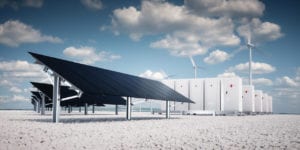Buildings are a major contributor to global emissions. Innovative technologies are available today to help cost-effectively reduce their carbon footprint; however, maximizing sustainable and financial impacts requires interaction between buildings and the main power grid.

We’re transitioning from a unidirectional energy delivery system to a more bi-directional flow of energy, leveraging the growth of on-site generation behind the meter. At the same time, the accelerating digitalization of buildings helps:
- Increase efficiency
- Cut costs
- Mitigate climate change
- Strengthen resilience
- Improve occupant well-being
Schneider Electric’s Bala Vinayagam (SVP Microgrid Business) and Andre Marino (SVP Digital Buildings Business) help explain the trends and technologies driving the transformation to grid-interactive buildings.
1. What is driving the grid and building decarbonization?
All types of energy consumers want greater control over their energy reliability and costs while adhering to commitments to decarbonize operations and meet emissions regulations. This drives the electrification of buildings and transit – e.g., replacing gas-fired boilers with heat pumps and installing electric vehicle (EV) chargers – and more on-site microgrids to help replace fossil fuels with solar, wind, or geothermal energy. Building owners and operators seek ways to optimize energy consumption and manage costs. Still, they also want the ability to participate in grid programs to mitigate price volatility with the option to consume grid energy when it is ‘greener.’
Electrical grids are transforming into ‘smart grids’ that enable two-way communication with energy consumers to handle the additional strain due to increasing electrification. Energy suppliers and consumers can now work together to decarbonize operations while dynamically managing increased demand without risking rolling blackouts.
2. Why integrate buildings with the grid?
Buildings can help promote grid stability by becoming energy generators and intelligently controlling loads to unlock demand-side flexibility. Digitalized buildings provide critical data to reveal energy consumption and emissions scopes. At the same time, a microgrid enables the self-consumption of green energy and the ability to generate revenue by selling excess power back to the grid. Grid integration also supports demand response program participation, enabling smart consumption adjustments to curtail loads on the grid when needed.
3. What systems support building-to-grid integration?
Automation is the catalyst in a building’s digitalization journey. It helps intelligently reconcile multiple variables: energy, costs, emissions, comfort, and healthy spaces. Three innovative, integrated systems can help you decarbonize while maximizing building performance:
- Building management system (BMS) – These software and hardware systems provide monitoring and control functions and automation to reduce energy use. IoT-based sensors integrate with a BMS to measure room occupancy, air quality, and more. An intelligent BMS automatically reduces HVAC and lighting in unoccupied areas, responds to energy-reduction signals, and maintains healthy and comfortable indoor environments.
- Energy and power management system (EPMS) – Combining energy submeters with an EPMS helps uncover areas or loads consuming the most energy (e.g., kitchen, warehouse, faulty chiller, etc.). The EPMS seamlessly integrates with the BMS, providing whole-building energy visualization, including load profiles and time-of-use energy consumption.
- Microgrid control system (MCS) – A microgrid connects on-site renewable generation and storage to manage when and how energy is stored, used, or exported to the grid. It connects and interacts with the main grid to allocate appropriate energy to each building system. A microgrid can also support a building during a grid blackout with energy storage.
Additional systems can help further optimize energy efficiency and decarbonization. For example, an EV charging management system can detect peak demand for EV charging and adjust charging accordingly. EVs can automatically charge when energy prices are low, on-site renewable energy is available, or grid energy is greenest. In response to grid signals, charging reduces when necessary.
4. What is unique about a grid-interactive building?
Using two-way communication, a grid-interactive building responds to energy marketplace signals by changing its behavior, enabling participation in smart grid programs such as capacity enablement, frequency regulation, demand response, or other ancillary services. It can stabilize supply fluctuations caused by intermittent grid-level solar or wind generation. As a building becomes more connected and intelligent, it can quickly understand and respond to system load demands.
5. How should a building owner or operator start this journey?
Schneider Electric offers and proven 3-step approach – Strategize, Digitize, and Decarbonize – to achieving net-zero sustainability for any type and size of the building.
Also, consider financial enablers – e.g., the US Inflation Reduction Act and Canada Clean Electricity Regulations – that offer incentives for efficiency, microgrid, demand response, and more to help reduce capital expenditures (CapEx) for upgrades.
Energy-as-a-Service (EaaS) is also an option for delivering microgrids with no upfront capital expense offered through Schneider’s strategic joint venture partnerships. Look for a solution provider that can orchestrate your grid-interactive building solution. Whether you are responsible for greenfield projects or retrofitting existing buildings, you need a structured roadmap to follow.
6. What will the future of the grid and grid-interactive buildings look like?
Grid-interactive buildings are a necessity to deeply decarbonize electrical infrastructures. Buildings are shifting from simple brick-and-mortar to dynamic energy generators, monetizing energy, and load flexibility by building owners. Thousands of centralized power plants on the grid will be augmented by millions of building-based energy generators coming online to provide greater stability. Grid utilities will use advanced distribution management (ADMS) and distributed energy resource management (DERMS) systems to aggregate groups of buildings into virtual power plants, enabling expansive demand response programs.
Schneider Electric considers itself a prime visionary and enabler of grid-interactive buildings and the smart grid. We have open and sophisticated solutions that can be deployed at scale.
To learn more about this topic, download our white paper “Integrating Smart Building Control Systems to Enable Grid-Interactive Buildings (GIB),” or visit our microgrids’ web page.



